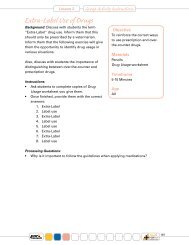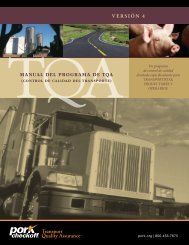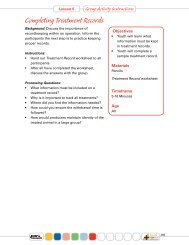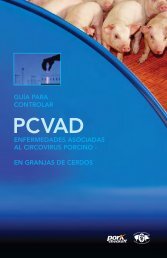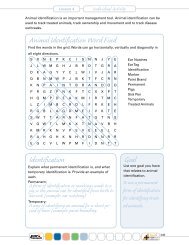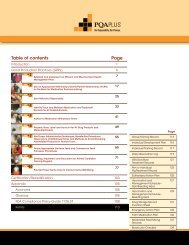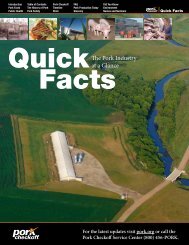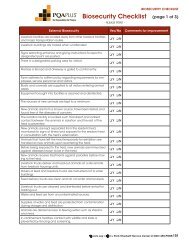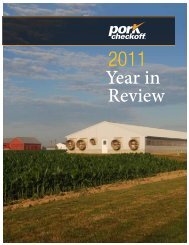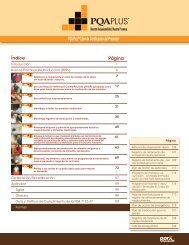Case Studies of Value Added Production and Marketing
Case Studies of Value Added Production and Marketing
Case Studies of Value Added Production and Marketing
You also want an ePaper? Increase the reach of your titles
YUMPU automatically turns print PDFs into web optimized ePapers that Google loves.
in November. Taylor related that shorting their customers on orders during this important sales<br />
season was not an option as it would create a breach in their relationships they had worked<br />
hard to develop.<br />
When asked about the core factors contributing to the success <strong>of</strong> the plant, Taylor ranked them<br />
from highest to lowest importance as:<br />
(1) Sales - All sales are confirmed before the pigs are slaughtered. With freshness<br />
as one key marketing point, this is critical.<br />
(2) Delivery on Sales - Many <strong>of</strong> their customers complain <strong>of</strong> being shorted on<br />
orders by the larger processors. This is related to their overall sales volume<br />
<strong>and</strong> order size. As a result Goridto ’ s’ customers are very sensitive to this issue.<br />
If Goridto ’ s shorts an order, they expect they will not have the customer again.<br />
(3) Collections - Taylor indicated that their customers are highly reliable on<br />
accounts receivable. However, if they allow collections to occur over 14 days,<br />
they accrue very large outst<strong>and</strong>ing credit on the volume. It is critical from a<br />
cash flow perspective not to let this get out <strong>of</strong> h<strong>and</strong>.<br />
(4) Plant, production <strong>and</strong> processing management - Once operating, plant operations<br />
are an ongoing concern. This is a small share <strong>of</strong> the risk <strong>of</strong> the operation,<br />
as it simply requires getting the job done.<br />
Goridto ’ s is now moving towards selling vacuum packaged primals rather than selling whole carcasses.<br />
As <strong>of</strong> January 1999, they were selling approximately 50 percent <strong>of</strong> their product as vacuum<br />
packed <strong>and</strong> 50 percent as whole carcasses. This seems to run against the earlier notion<br />
that whole carcasses were necessary. However, the primals are still cut to the same styles as<br />
Hispanic meat-cutters would do in store, so they are still meeting preferences. It concedes to<br />
the economics <strong>of</strong> in store fabrication <strong>of</strong> whole carcasses <strong>and</strong> merch<strong>and</strong>ising problems. The<br />
cost <strong>of</strong> hiring meat-cutters to fabricate the whole carcass in store is greater than it costs for<br />
Goridto ’ s to do the next step in processes (i.e., break <strong>and</strong> package the primals). Just as boxed<br />
cuts have replaced carcasses in the mainstream market channel, it better responds to the needs<br />
<strong>and</strong> economics <strong>of</strong> the grocery customers. At the same time, this places the merch<strong>and</strong>ising burden<br />
more directly on Goridto ’ s <strong>and</strong> at the time we visited they were beginning to stockpile<br />
shoulders <strong>and</strong> skins. Goridto ’ s compensates somewhat by being able ship 20% greater quantity<br />
by shipping on an in the box basis. This point best illustrates the trade-<strong>of</strong>fs which can be<br />
incorporated to take advantage <strong>of</strong> serving preferences on an economically viable basis. As<br />
always, Goridto ’ s is attempting to provide what their customers dem<strong>and</strong>.<br />
Bo McDonald manages the two LaRanchera stores affiliated directly with Goridto ’ s (one in<br />
Logan <strong>and</strong> one in Provo). This is a key component <strong>of</strong> their overall marketing strategy. First, it<br />
allows them to continue to have direct interaction with their customers which they then can use<br />
to develop or test new markets. They are investigating the addition <strong>of</strong> other stores as the<br />
retail interface returns the highest pr<strong>of</strong>its <strong>and</strong> they also gain direct access to the final consumer<br />
<strong>and</strong> are better able to provide <strong>and</strong> develop products suiting their customers’ needs. They did<br />
not provide direct sales <strong>and</strong> cost estimates <strong>of</strong> the retail operation. However, they did provide<br />
the estimates from the feasibility plan for a new proposed store which was based on figures<br />
from the existing stores. Gross meat sales are expected to be generate approximately $300-<br />
400,000 annually. The proposed store is 1,000 square feet, only slightly smaller than the existing<br />
Provo store. They further project that they will require about 6,650 regular customers to<br />
make their sales projections above <strong>and</strong> sell approximately 1,000 pounds <strong>of</strong> pork <strong>and</strong> 1,000<br />
pounds <strong>of</strong> beef per week. Employment requirements are also low, requiring owner/manager<br />
input plus 3 others. As a bottom line figure, they have developed a projection <strong>of</strong> net pr<strong>of</strong>it on<br />
sales to be 32 percent. The very low cost structure is part <strong>of</strong> the overall benefit <strong>of</strong> this particular<br />
chain. Many Hispanic customers prefer to shop neighborhood markets in contrast to the<br />
-17-





